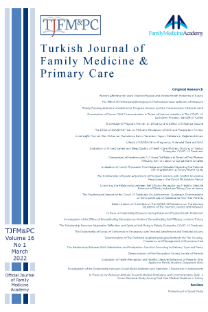One-Year Evaluation of Family Medicine Obesity Clinic Applications
Obesity, family medicine, primary care, obesity management,
___
- 1. The GBD 2013 Obesity Collaboration. Global, regional and national prevalence of overweight and obesity in children and adults 1980-2013: A systematic analysis. Lancet.2014; 384(9945): 766-781.
- 2. Swinburn BA, Sacks G, Hall DK, McPherson K, Finegood DT, Moodie ML, Gortmaker SL. The global obesity pandemic: shaped by global drivers and local environments. Lancet 2011; 378: 804–14.
- 3. World Health Organization. Global Status Report on noncommunicable diseases. 2014.Switzerland. Accessed on http://www.who.int/nmh/publications/ncd-status-report-2014/en/ at 17.07.2018
- 4. Dietz WH, Robinson TN. Clinical practice. Overweight children and adolescents. N Engl J Med. 2005; 352(20): 2100-9.
- 5. The Emerging Risk Factors Collaboration. Separate and combined associations of body-mass index and abdominal adiposity with cardiovascular disease: collaborative analysis of 58 prospective studies. Lancet.2011; 377:1085–95.
- 6. Prospective Studies Collaboration. Body-mass index and cause-specific mortality in 900 000 adults: collaborative analyses of 57 prospective studies. Lancet.2009; 373: 1083–96.
- 7. Finkelstein EA, Trogdon JG, Cohen JW, Dietz W. Annual Medical Spending Attributable to Obesity: Payer-And Service-Specific. Health Affairs.2009; 28(5): 822-83.
- 8. Satman I, Omer B, Tutuncu Y et al Twelve-year trends in the prevalence and risk factors of diabetes and prediabetes in Turkish adults. Eur J Epidemiol.2013;28:169–180.
- 9. Compernolle S, Decocker K, Abbott G. Do sedantery behaviours mediate associations between socio-demographic characteristics and BMI in women living in socio-economically disadvantaged neighborhoods. International Journal of Behavioral Nutrition and Physical Activity.2015; 12:48.
- 10. Bakhshi E, Eshraghian MR, Mohammad K, Foroushani AR, Zeraati H, Fotouhi A et al. Sociodemographic and smoking associated with obesity in adult women in Iran: Results from the National Health Survey. J Public Health. 2008; 30:429-35.
- 11. Alvarez AG, Majem LS, Barba LR, Castell C, Faz M, Uauy R et al. Obesity and overweight trends in Catalonia, Spain (1992-2003): Gender an socio-economic determinants. Public Health Nutr. 2007; 10:1368-78.
- 12. Fouad MF, Rastam S, Ward KD, Maziak W. Prevalence of Obesity and Its Associated Factors in Allepo, Syria. Prev Control. 2006; 2:85-94.
- 13. Maskarinec G, Takata Y, Pagano I, Carlin L, Goodman M, Marchand L, Nomura A. Trends and Dietary Determinants of Overweight and Obesity in A Multiethnic Population. Obesity. 2006; 14:717-26.
- 14. Hosseinpour NS, Mirmiran P, Hosseinpanah GF, Azizi F. Association of Marital Status and Marital Transition With Metabolic Syndrome: Tehran Lipid and Glucose Study. Int J Endocrinol Metab. 2014; 12(4): e18980.
- 15. Álvarez AG et al Obesity and overweight trends in Catalonia, Spain (1992–2003): gender and socio-economic determinants. Public Health Nutrition.2007;10(11A):1368–1378.
- 16. MF Fouad et al Prevalence of obesity and its associated factors in Aleppo, Syria.Prev Control. 2006; 2(2): 85–94.
- 17. Maskarinec G et al Trends and Dietary Determinants of Overweight and Obesity in a Multiethnic Population. Obesity (Silver Spring).2006; 14(4): 717-26.
- 18. Hosseinpour NS et al Association of Marital Status and Marital Transition withMetabolic Syndrome: Tehran Lipid and Glucose Study.Int J Endocrinol Metab.2014; 12(4): e18980.
- 19. Foster GD et al What is a reasonable weight loss? Patients' expectations and evaluations of obesity treatment outcomes.J Consult Clin Psychol. 1997; 65(1): 79-85.
- 20. National Institutes of Health, National Heart, Lung, and Blood Institute, North American Association for The Study of Obesity.The Practical Guide Identification, Evaluation, and Treatment of Overweight and Obesity in Adults.2013. Accessed on http://www.nhlbi.nih.gov/files/docs/guidelines/prctgd_c.pdfat 17.07.2018
- 21. Wing RR, Pinto AM, Niemeier H. Maintenance: The Ultimate Goalin A ClinicalManagament of Overweight and Obese Children and Adults.Apovian CM, Lenders CM. First Edition.Taylor and Francis, Florida.2007: 192.
- ISSN: 1307-2048
- Yayın Aralığı: 4
- Başlangıç: 2007
- Yayıncı: -
Hacer Alan Dikmen, Seyhan Çankaya
ÜNİVERSİTE ÖĞRENCİLERİNDE İNTERNET BAĞIMLILIĞININ DEPRESYON VE ANKSİYETE İLE İLİŞKİSİ
Başak KORKMAZER, Mehmet Göktuğ KILINÇARSLAN, Erkan Melih ŞAHİN
Evli Kadınların Aile İçi Şiddete İlişkin Tutumlarının İncelenmesi
Arzu Yıldırım, Rabia H. Aşılar, İlknur A. Avcı
Erkan BERKE, Ümit AYDOĞAN, Yusuf Ç. DOĞANER, Sedat YILMAZ
Servet Aker, Esra B. Aker, Emine Z. Tuzcular
ARZU YILDIRIM, Rabia H. AŞILAR, İlknur A. AVCI
Sağlık okuryazarlığı seviyesini göz önünde bulundurmak Aile Hekimleri için neden önemlidir?
